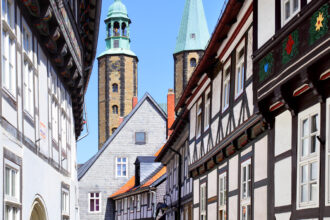One of Milan’s most charming districts is located on the banks of the Naviglio, where craftsmen and workers once lived. Today, it is home to artists’ studios, original shops, trendy bars, flea markets, and concerts. For me, the Navigli, Milan’s beautiful waterways, are an essential part of any visit to Milan. That’s why I didn’t miss the opportunity to take a detour there. Under a bright blue sky and lots of sunshine, I set out to explore this popular district with its countless restaurants and bars. I strolled happily along the canals, admiring the old houses with their wooden roofs, reminiscent of a bygone era. The Navigli is a sophisticated system of canals and waterways, which took an incredible seven centuries to build and connects Lake Maggiore, Lake Como, the Ticino River, and the Po River. They also connect Milan with Switzerland, northeastern and western Europe, and the major industrial areas. The canal system of the city of Milan includes the Naviglio Grande, the Naviglio Pavese, the Naviglio Martesana, the Naviglio Paderno, and the Naviglio di Bereguardo. The first canal, Naviglio Grande, was built in the 12th century in a record time of 35 years, with 90 kilometers of waterways. The construction of the Naviglio Grande was further developed in the 15th century by Leonardo da Vinci with a system of locks. I was able to admire this construction on the Naviglio Pavese. The Pavia Canal, which, as its name suggests, connects Milan with the city of Pavia, was not completed until the Napoleonic era. It begins at the Darsena canal basin under the so-called Trofeo Bridge. Locks enable it to negotiate differences in elevation at various points along its 33-kilometer route, culminating in a visually striking sequence at the point where the canal flows into the Ticino. When the canal was opened to navigation in 1819, Milan was finally connected to the Adriatic Sea via the Ticino and the River Po. This project, which began in the 15th century with the construction of the Bereguardo Canal, connecting the Naviglio Grande with the Ticino near Pavia, and the Martesana Canal, for which Leonardo da Vinci developed a system of locks to allow the waters of the Adda River to flow into the Milan canal ring, made the city a crossroads between continental Europe and the Mediterranean. Today, the banks of the two canals in the Navigli district are lined with a whole host of commercial enterprises, arts and crafts businesses, bars, and nightclubs, making it one of the liveliest parts of the city. The hub of Navigli life is the Darsena basin, which was created in 1603 as an inner-city dock. It is fed by the waters of the Naviglio Grande and the Olona River, which now flows underground, and these in turn feed the Naviglio Pavese. The city’s inner canal ring, which was covered over in 1929-1930, also flowed into this basin via the Viarenna lock, now Via Conca del naviglio. The Navigli district, with its deep green waters, iconic bars and restaurants, and ornate iron bridges, is simply beautiful. I enjoyed every minute in this wonderful district and felt as if I were strolling along the many canals in Venice. The Navigli district is simply worth seeing and, especially in the evening, it transforms into a cool nightlife district where people party and dance until the early hours of the morning. For me, the district is simply a beautiful spot that everyone should see at least once.





























